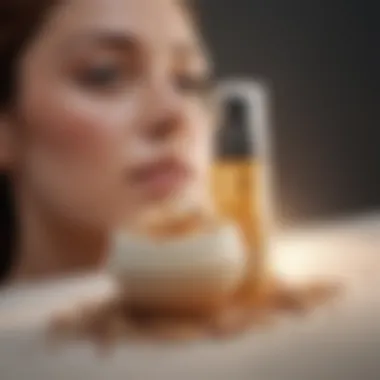The Safest Moisturizers with SPF for Healthy Skin


Intro
The quest for effective skin hydration while ensuring sun protection remains paramount for many individuals. In recent years, the awareness surrounding the damaging effects of UV rays has catalyzed an increasing interest in moisturizers combined with SPF. Consumers seek products that not only provide moisture but also safeguard against harmful radiation that can lead to premature skin aging and increased cancer risk. This guide will examine the critical aspects of choosing the safest moisturizers with SPF, emphasizing the significance of their ingredients and formulations.
Understanding the components of these products can help in making informed decisions. This article will dissect various formulations and highlight essential factors such as regulatory standards and dermatological recommendations. By the end of this overview, readers will gain a comprehensive understanding of what constitutes a safe and effective moisturizer with SPF.
Key Characteristics of Safest Moisturizers with SPF
Identifying the safest moisturizers is not just about brand names; it involves a deep understanding of the ingredients and their purposes. Various components play a crucial role in the efficacy and safety of these products.
Ingredients to Look For
- Zinc Oxide: This mineral offers broad-spectrum protection and is known for its gentle nature on the skin.
- Titanium Dioxide: Another mineral that provides sun protection. It suits sensitive skin types as well.
- Hydrating Agents: Ingredients like hyaluronic acid or glycerin attract moisture, enhancing skin hydration.
- Antioxidants: These help combat free radicals caused by UV exposure. Common ones include Vitamin C and E.
Ingredients to Avoid
- Parabens: Preservatives that may disrupt hormonal balance.
- Synthetic Fragrances: These can cause irritation in sensitive skin.
- Alcohol: May dry out the skin, counteracting hydration efforts.
“Choosing a moisturizer with SPF is vital for daily skin care, especially in harsh sun conditions.”
Formulations of Moisturizers with SPF
Different formulations cater to various skin types and concerns. This section will explore the common types and their respective benefits.
Creams and Lotions
Creams tend to be thicker and offer more hydration, ideal for dry skin types. Lotions are lighter, making them suitable for oily or combination skin. Both should provide adequate sun protection if formulated correctly.
Gels and Oils
These are often preferred for their lightweight feel, particularly in warmer climates. They absorb quickly and often leave a non-greasy finish.
Tinted Moisturizers
These products serve a dual purpose by combining hydration, sun protection, and coverage. They can even out skin tone while keeping skin nourished.
Consumer Preferences and Insights
Understanding consumer preferences plays a vital role in product formulation. A growing number of individuals prioritize clean beauty products, leading brands to innovate and offer safer options.
Popular Choices
- EltaMD UV Clear Broad-Spectrum SPF 46: Known for its lightweight formula and effectiveness.
- La Roche-Posay Anthelios Melt-in Milk Sunscreen: Highly rated for its moisturizing properties.
- Neutrogena Hydro Boost Water Gel Lotion SPF 30: Praised for combining hydration with SPF.
As consumer knowledge increases, the demand for transparent ingredient listings rises. Individuals now look for products free from potentially harmful chemicals, influencing market trends towards safer formulations.
Epilogue
The selection of the safest moisturizer with SPF is a nuanced process that necessitates understanding ingredients, formulations, and consumer needs. By paying attention to these factors, individuals can make informed choices that protect their skin effectively while providing the necessary hydration. Moving forward, the emphasis on safe skincare will likely continue to grow, fostering a more informed consumer base.
Preamble to Moisturizers with SPF


In the realm of skincare, the importance of moisturizers with SPF cannot be overstated. These products serve dual purposes: they hydrate the skin while providing necessary protection against harmful ultraviolet (UV) rays. With the increasing awareness of skin health, individuals are becoming more attentive to their choices in skincare, leading to a demand for moisturizers that effectively combine hydration and sun protection. The need for this balance arises from the fundamental understanding that hydration is crucial for maintaining skin elasticity and overall appearance, while sun protection is essential for preventing skin damage, premature aging, and skin cancer.
Moisturizers with SPF have become pivotal in daily routines, especially as they simplify application by offering two benefits in one product. Users no longer need to layer multiple products, which can often lead to heavy or greasy skin. Instead, an efficient, lightweight option allows individuals to apply a single product, streamlining their skincare rituals. Yet, safety considerations must be foremost in mind when selecting these products, as not all formulations offer the same level of protection or hydrating qualities.
Understanding SPF and Its Importance
Sun Protection Factor (SPF) is a measure of how well a product protects the skin from UV radiation. Specifically, SPF labels indicate the percentage of UVB rays prevented from penetrating the skin. To truly understand SPF, one must accept that it is not just a number, but a guideline aimed at informing consumers how much longer they can remain in the sun without burning compared to not wearing sunscreen. For example, if a person typically burns after 10 minutes in the sun, applying an SPF 30 theoretically allows for 300 minutes of sun exposure. However, real-world factors such as sweating, swimming, and the application of a product can diminish its effectiveness. This means that the application of SPF must be done diligently and re-applied as needed.
Moreover, it is crucial to consider both UVB and UVA rays in sun protection. While SPF focuses primarily on UVB rays, which cause burning, UVA rays penetrate deeper into the skin and contribute to skin aging and cancer. Therefore, choosing a broad-spectrum product is essential. Consumers must understand that higher SPF does not correlate with linear increases in protection, leading to common misconceptions regarding how much sunscreen is truly needed. Thus, educating oneself on SPF and its implications is vital for anyone looking to protect their skin effectively.
The Role of Moisturizers in Skincare
Moisturizers play a vital role in any effective skincare regimen. They are designed to enhance the skin's barrier, encouraging moisture retention while preventing dryness. As environmental factors and lifestyle choices can lead to skin dehydration, the use of an appropriate moisturizer is critical in maintaining a healthy complexion. These products can accommodate various skin types, ranging from oily to dry, and offer specific benefits based on their ingredients.
Incorporating a moisturizer that contains SPF augments these benefits by providing a correlative layer of protection against UV damage. However, not all moisturizers are created equal. Understanding the formulation and the specific needs of one’s skin is key to making informed choices. While some moisturizers focus solely on hydrating properties, those that also include SPF contribute to a comprehensive strategy for skin health. Individuals should look out for products that include ingredients like hyaluronic acid and glycerin, which help to maintain moisture levels while ensuring their skin is shielded from harmful rays.
In summary, utilizing moisturizers with SPF is more than just a cosmetic choice; it is an essential practice rooted in the desire for healthy skin. By understanding SPF, recognizing the importance of moisturizers in skincare, and selecting suitable products, individuals can better protect themselves against sun damage while enjoying the benefits of hydrated skin.
Key Ingredients in Safe Moisturizers with SPF
The importance of key ingredients in moisturizers with SPF cannot be overstated. These elements form the backbone of products that aim to combine hydration with sun protection, a critical requirement for maintaining skin health. Different ingredients serve various functions, from providing protection against UV rays to delivering hydration and stability in the formulation. Understanding these ingredients is essential for making informed choices when selecting a moisturizer that assures both safety and efficacy.
Active Ingredients for Sun Protection
Zinc Oxide
Zinc oxide is a widely recognized ingredient in the realm of sun protection. Its physical blocking action makes it effective against both UVA and UVB rays. The key characteristic of zinc oxide is its ability to create a barrier on the skin that reflects and scatters harmful radiation. This aspect makes it a popular choice, particularly for those with sensitive skin, as it is less likely to cause irritation compared to chemical sunscreens. Additionally, zinc oxide has anti-inflammatory properties, which can benefit those dealing with skin conditions like rosacea or acne. However, its thick texture may not appeal to all users, as it can leave a noticeable white cast on the skin.
Octocrylene
Octocrylene is a chemical sunscreen that absorbs UVB rays effectively. Its key characteristic is its stability under sunlight, which enhances the overall performance of the sunscreen when combined with other active ingredients. Its role as a solvent for other UV filters can improve the texture of the formulation, allowing for a lighter application. Octocrylene’s unique feature is its moisturizing properties, helping to prevent skin from drying out. Despite its benefits, some studies suggest potential allergenic responses in certain individuals, making patch testing a prudent approach before regular use.
Titanium Dioxide
Titanium dioxide is another physical sunscreen agent that offers excellent UV protection. Its ability to reflect sunlight is its primary contribution to sun defense. The key characteristic of titanium dioxide is its gentle nature, making it suitable for sensitive or irritated skin. Moreover, it is often used in formulations designed for children or individuals prone to allergies. A unique feature of titanium dioxide is its additional role in providing a matte finish, which can appeal to those with oily skin. However, like zinc oxide, it can leave a white residue, which may deter some users from choosing products containing this ingredient.
Hydrating Agents
Glycerin
Glycerin serves as a powerful humectant in moisturizers. It attracts water from the environment into the skin, leading to enhanced hydration. The key characteristic of glycerin is its ability to provide deep moisture without feeling greasy. This makes it a beneficial component in formulations aimed at both hydration and sun protection. Unique to glycerin is its compatibility with a wide range of skin types, including oily, dry, and combination skin. However, individuals in extremely dry climates might find it less effective without additional occlusive agents to lock in moisture.
Hyaluronic Acid
Hyaluronic acid is known for its incredible capacity to hold moisture—up to 1,000 times its weight in water. The significant characteristic of hyaluronic acid is its ability to give skin a plump and youthful appearance. It works by attracting moisture to the skin's surface while providing a soothing effect. As a hydrating agent, it is a highly beneficial choice for anyone seeking to maintain skin elasticity and hydration. One disadvantage may be its reliance on surrounding moisture; in very dry conditions, its efficiency in hydration might decrease if not paired with other ingredients that can seal in moisture.
Aloe Vera
Aloe vera is lauded for its soothing and anti-inflammatory properties, making it a popular choice in many skincare products. Its key characteristic is its cooling effect on the skin, which can be particularly beneficial after sun exposure, even with SPF. Aloe vera provides hydration as well as nourishment due to its rich content of vitamins and minerals. A unique feature of aloe is its ease of absorption, so it won’t leave a heavy or oily residue. Concerning drawbacks, some individuals may experience sensitivities to aloe, suggesting that patch testing is advisable.
Preservatives and Their Effects
Parabens


Parabens are commonly used preservatives in moisturizers to prevent microbial growth. The key characteristic of parabens is their broad-spectrum effectiveness, allowing them to protect products from spoilage. They are widely considered beneficial as they extend the shelf life of skincare products. However, there is ongoing debate regarding their safety, with some studies linking them to hormonal disruptions. Consequently, consumers are increasingly mindful of choosing paraben-free products as a precautionary measure to avoid potential risks.
Natural Alternatives
Natural preservatives, such as rosemary extract and essential oils, are gaining popularity as safer options in moisturizers. The key characteristic of natural alternatives is their lower risk of skin irritation compared to synthetic preservatives. They provide antimicrobial protection while appealing to a growing segment of the market that prefers clean beauty products. Unique to natural alternatives is their environmental friendliness, aligning with consumer values focused on sustainability. On the other hand, their efficacy can vary, and they may not provide the same broad-spectrum protection as traditional preservatives, which raises concerns about product stability.
Regulatory Standards for Skincare Products
Regulatory standards play a crucial role in ensuring that skincare products, especially those that claim to offer sun protection, are safe and effective for consumer use. In the context of moisturizers with SPF, these standards help consumers make informed choices about the products they apply to their skin. Understanding the regulations offers insights into the quality and reliability of sun protection claims.
First, regulatory bodies like the U.S. Food and Drug Administration (FDA) set specific guidelines for how SPF products are manufactured, tested, and marketed. These guidelines aim to minimize harmful effects on skin health, ensuring that products not only provide adequate sun protection but also do not lead to adverse reactions.
The benefits of robust regulatory standards cannot be overstated. They:
- Ensure that the SPF claims on products are scientifically validated.
- Provide guidelines on labeling, which aids consumers in making clear and informed decisions.
- Oversee the testing process, which includes evaluating the product's effectiveness against harmful UV rays.
- Foster a competitive marketplace where brands strive to meet or exceed safety standards, ultimately benefitting the consumer.
In summary, understanding regulatory frameworks is essential for anyone looking to choose safe moisturizers with SPF. Comprehending these standards helps disentangle marketing claims from reality, ensuring a level of protection and efficacy aligned with consumer expectations.
FDA Regulations on SPF Products
The FDA has established comprehensive regulations specifically for sunscreens, including moisturizers that combine hydrating properties with ultraviolet protection. These regulations focus on how products are tested, labeled, and marketed.
One key aspect of these regulations is the requirement for products to undergo rigorous testing to substantiate their SPF claims. The FDA mandates that products labeled with an SPF rating must demonstrate their ability to protect against UV radiation through standardized testing methods. This ensures that consumers can trust the claims made on the packaging.
Additionally, the FDA categorizes sunscreens as either Over-The-Counter (OTC) drugs, which implies a higher standard of scrutiny regarding their safety and efficacy. As a result, brands marketing moisturizers with SPF must comply with precise testing and labeling regulations to ensure consumer safety. This type of oversight not only protects the public but also promotes trust in reputable brands that adhere to these guidelines.
Testing and Labeling Requirements
Testing and labeling are integral to the effective regulation of moisturizers with SPF. Under FDA guidelines, products must pass several testing phases to determine their sun protective factors accurately.
The key elements of these testing protocols include:
- Broad Spectrum Testing: Products marketed as providing broad-spectrum protection must be tested for both UVA and UVB rays. This indicates that they can help reduce risks associated with skin cancer and skin damage.
- Water Resistance Testing: Many consumers prefer products that remain effective while sweating or swimming. The FDA has distinct categories for water resistance, requiring specific testing protocols to back these claims.
- Label Information: Products must include clear and concise information about how to use them effectively, as well as potential warnings regarding their limitations. By adhering to these rules, the labeling provides essential guidelines helping consumers understand the product better.
"Clear labeling and rigorous testing protect consumers while ensuring proper use of moisturizers that offer SPF."
Evaluating the Safety of Moisturizers with SPF
When it comes to skincare, particularly with products that combine hydration and sun protection, evaluating safety is essential. A moisturizer with SPF may offer dual benefits, but it must also meet safety standards to protect the skin effectively. Factors such as dermatological testing and allergen identification are critical. These evaluations ensure that the product not only protects against UV damage but also minimizes the risk of adverse skin reactions.
Understanding the safety of these products enables consumers to make informed choices. Moreover, taking into account scientific studies and dermatologists' recommendations can help guide individuals toward products that align with their skin types and personal health concerns.
Dermatological Testing and Recommendations
Patch Testing
Patch testing involves applying a small amount of the product to the skin and observing for any reactions over a couple of days. This method is significant because it can identify potential irritants or allergens before widespread use. The primary characteristic of patch testing is its simplicity and direct approach. It allows consumers to understand how their skin may react to the product.
Being a beneficial choice for this article means that patch testing can contribute to heightened safety awareness. It is often recommended by dermatologists to determine if a moisturizer with SPF suits an individual’s skin. The unique feature of this testing is its focus on the individual reaction rather than generalized testing, which may not account for all skin types. However, it can be time-consuming and does not cover all potential allergens.
Consumer Safety Studies
Consumer safety studies evaluate how a product performs when used as recommended by the majority of users. They often include diverse demographics to observe a range of reactions and effectiveness. A major aspect of these studies is their significance in validating the claims made by manufacturers. They are a popular choice for this article due to their wide-ranging insights into consumer experiences.


The unique feature of consumer safety studies lies in their collective data, often presenting comprehensive findings that reflect the experiences of multiple users. These studies come with the advantage of broader applicability, but they may not account for individual skin sensitivities or unique skin conditions.
Identifying Allergens and Irritants
Identifying allergens and irritants in moisturizers with SPF is crucial for consumers who have sensitive skin. Ingredients like fragrances, parabens, and certain chemical filters can provoke reactions in some individuals. Detailed ingredient lists should be scrutinized to avoid any known irritants.
When choosing products, looking for hypoallergenic labels can also assist in reducing the risk of allergic reactions. The importance lies in knowing one’s skin type and past reactions to ingredients, which aids in making better decisions.
"Seeking products without common allergens can significantly enhance your overall skincare experience."
In summary, understanding the safety aspects of moisturizers with SPF encompasses recognizing the need for patch testing, referring to consumer safety studies, and identifying potential allergens. This holistic approach enables consumers to prioritize their skin's health while enjoying the benefits of hydration and sun protection.
Consumer Preferences and Trends
Understanding consumer preferences and trends is essential in determining the safest moisturizers with SPF. This section will outline key elements that reflect what consumers prioritize when selecting skincare products that offer sun protection while also meeting hydration needs.
Importance of Consumer Preferences
Consumer preferences shape the market significantly. As the awareness of skincare ingredients grows, buyers are more discerning. They want to know what is in their products and how these ingredients can benefit their skin. Many consumers today consciously look for moisturizers with broad-spectrum SPF; they understand the importance of protection from both UVA and UVB rays. Moreover, the demand for non-toxic, environmentally friendly, and cruelty-free products is on the rise. This shift emphasizes the need for brands to reformulate their products according to these standards in order to appeal to a more educated consumer base.
In addition, consumers often seek products that suit their specific skin types. For example, those with oily skin might prefer a lightweight moisturizer with SPF, while individuals with dry skin may opt for richer, creamier formulations. Brands must deliver solutions that cater to these diverse needs while ensuring safety and efficacy.
Popular Brands Offering Safe Moisturizers with SPF
Several brands have emerged as frontrunners in the market for safe moisturizers with SPF. These brands emphasize both safety and effectiveness, attracting consumers who are mindful of their skincare choices. Some notable brands include:
- EltaMD - Renowned for their dermatologist-recommended formulations, EltaMD offers moisturizers that provide hydration and broad-spectrum SPF protection.
- Neutrogena - Known for a range of affordable and effective products, Neutrogena has several options that combine hydration with sun protection.
- La Roche-Posay - This brand focuses on sensitive skin and incorporates carefully selected ingredients that provide both moisture and sun defense.
Consumer Reviews and Feedback
Consumer reviews are valuable for assessing the performance and safety of moisturizers with SPF. Many individuals will express their thoughts on the feel, texture, and effectiveness of these products. Positive feedback often highlights the following aspects:
- Texture - Many users appreciate formulas that are lightweight and do not clog pores, while still providing adequate hydration.
- Efficacy - Customers look for real-life results; they want to know if a product protects against sunburn and does not cause irritation.
- Scent - Subtle, pleasant fragrances are typically preferred, as overpowering scents can be off-putting.
Negative reviews can help identify potential allergens or irritants. Consumers often mention specific reactions, which can guide others in selecting suitable products. Overall, feedback helps brands improve their offerings to better meet consumer needs.
Final Thoughts and Recommendations
The discussion around safe moisturizers with SPF is crucial for anyone keen on maintaining skin health while enjoying the outdoors. These products serve a dual purpose, simultaneously providing hydration and protection from harmful ultraviolet rays. The final recommendations carry weight because they summarize significant insights from previous sections. Choosing the right product is not merely a matter of personal preference; it involves understanding the formulation, knowing your skin type, and ensuring the product meets safety standards.
When selecting moisturizers with SPF, consider the active ingredients listed and their proven efficacy against UV damage. Look for ingredients like Zinc Oxide and Titanium Dioxide, which are known for their effectiveness. It's also important to assess personal skin concerns such as sensitivity or allergies. Products that undergo dermatological testing often offer better assurance regarding safety.
In essence, the right moisturizer can bolster your skincare routine and shield your skin from potential damage.
How to Choose the Right Moisturizer with SPF
Choosing the right moisturizer with SPF requires careful evaluation of several factors. Start by identifying your skin type. For oily skin, lightweight formulations that do not clog pores are more suitable. If your skin is dry, look for moisturizers rich in hydrating agents like Glycerin or Hyaluronic Acid. These ingredients not only provide moisture but also enhance the skin's barrier function.
Another consideration is the SPF level. Generally, products with SPF 30 or above offer substantial protection. However, personal lifestyle and sun exposure determine what is right for you. If you spend long periods outdoors, higher SPF is necessary.
Ingredients matter as well. Make it a point to examine the label for parabens or other synthetic preservatives that may irritate sensitive skin. Consumer reports and dermatological recommendations can aid in identifying trustworthy brands.
Daily Application Tips for Optimal Protection
To maximize the benefits of moisturizers with SPF, adhere to a consistent application routine. Here are some key tips:
- Apply Generously: Use enough product to cover all exposed areas of skin. This is essential to ensure a proper level of UV protection.
- Timing is Key: Apply moisturizer about 15-30 minutes before sun exposure. This gives the product time to absorb and become effective.
- Reapply Regularly: If outdoors for extended periods or sweating, reapply every two hours. Water-resistant formulas may allow for longer intervals but check the product guidelines.
- Layering Products: If using makeup, apply your moisturizer with SPF as part of your skincare routine beneath your makeup. This ensures a protective base.
By following these guidelines, you can enjoy the sun safely and keep your skin nourished. Taking these steps reflects a commitment to both skincare and protection in a balanced manner.















